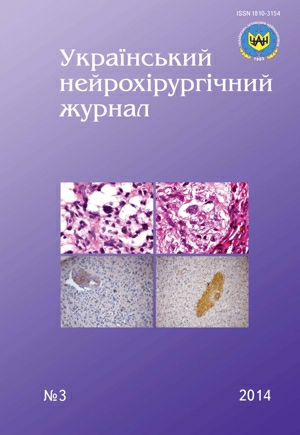Surgical treatment of aresorbtive hydrocephalus in remote period after rupture of the brain arterial aneurysm
DOI:
https://doi.org/10.25305/unj.47490Keywords:
subarachnoid hemorrhage, arterial aneurysm, aresorbtive hydrocephalusAbstract
Introduction. Spontaneous subarachnoid hemorrhage (SAH) — is a typical manifestation of rupture of the brain arterial aneurysm (AA) and the cause of pathological cascade changes including impairment of CSF dynamic. Initial manifestations of impairment of CSF dynamic have progredient course and transform into aresorbtive hydrocephalus.
Materials and methods. The results of surgical treatment of 107 patients with aresorbtive hydrocephalus in the remote period of AA rupture were analyzed. The patients were operated in a clinic in 2009–2014.
Results. The typical disease flow noted in 72% patients and was characterized by progressive dementia, gait and urinary disorders. In 28% patients combination of typical disease manifestations with ischemic brain changes was determined. In the acute period CSF shunting operations were performed in 107 patients, in 102 of them — ventriculoperitoneal ,and in 5 — lumboperitoneal shunting.
Conclusions. Surgical treatment of aresorbtive hydrocephalus that developed in the remote period after brain AA rupture is an effective method for treatment and prevention of hydrocephalic and secondary ischemic brain lesion, lead to the improvement of the quality of life of operated patients.
References
Burov SA, Krylov VV. Prognozirovaniye khronicheskoy gidrotsefalii posle netravmaticheskikh subarakhnoidal'nykh krovoizliyaniy [Prediction of chronic hydrocephalus after nontraumatic subarachnoid hemorrhage]. In: Abstracts of the 1st Russian International Congress “Cerebrovascular pathology and the stroke”. Zhurnal nevrologii i psikhiatrii imeni S.S. Korsakova. 2005; special edition:55-56. Russian.
Krylov VV., editor. Khirurgiya anevrizm golovnogo mozga [Brain aneurysm’s surgery]. Moskva: Meditsina; 2012. V.3. p.90-110. Russian.
Krylov VV, Burov SA. Otdalennyye rezul'taty khirurgicheskogo lecheniya anevrizm golovnogo mozga v ostrom periode krovoizliyaniya [Long-term results of surgical treatment of cerebral aneurysms in acute hemorrhage]. Neurokhirurgia. 2000;4:61-66. Russian.
Krylov VV, Eddin AA, Sharifullin FA, Siniakova OG. [Hydrocephalus and it’s significance in the early surgical treatment of cerebral aneurysms].Zh. Vopr. Neirokhir. Im. N.N. Burdenko. 1994;3:5-9. Russian. [PubMed]
Lebedev VV, Krylov VV. Neotlozhnaya neyrokhirurgiya: rukovodstvo dlya vrachey [Emergency Neurosurgery: Guidelines for Physicians]. Moskva: Meditsina; 2000. Russian.
de Oliveira JG, Beck J, Setzer M, Gerlach R, Vatter H, Seifert V, Raabe A. Risk of shunt-dependent hydrocephalus after occlusion of ruptured intracranial aneurysms by surgical clipping or endovascular coiling: a single-institution series and meta-analysis. Neurosurgery. 2007;61(5):924-934. [CrossRef] [PubMed]
Kwon JH, Sung SK, Song YJ, Choi HJ, Huh JT, Kim HD. Predisposing factors related to shunt dependent chronic hydrocephalus after aneurismal subarachnoid hemorrhage. J. Korean Neurosurg.Soc. 2008;43(4):177-181. [CrossRef] [PubMed]
Widenka DC, Wolf S, Schurer L, Plev DV, Lumenta CB. Factors leading to hydrocephalus after aneurysmal subarachnoid hemorrhage. Neurol. Neurochir. Pol. 2000(6);34:56-60. [PubMed]
Varelas P, Helms A, Sinson G, Spanaki M, Hacein-Bey L. Clipping or coiling of ruptured cerebral aneurysms and shunt-dependent hydrocephalus. Neurocrit. Care. 2006;4(3):223-228. [CrossRef] [PubMed]
Adams RD, Fisher CM, Hakim S, Ojemann RG, Sweet WH. Symptomatic occult hydrocephalus with “normal” cerebrospinal fluid pressure: a treatable syndrome. New Engl. J. Med. 1965;273:117-126. [PubMed]
Hakim S, Adams RD. The special clinical problem of symptomatic hydrocephalus with normal cerebrospinal fluid pressure. Observations on cerebrospinal fluid hydrodynamics. J. Neurol. Sci. 1965;2(4):307-327. [PubMed]
Damasceno BP, Carelli EF, Honorato DC, Facure JJ. The predictive value of cerebrospinal fluid tap-test in normal pressure hydrocephalus. Arh. Neuropsiquiatr. 1997;55(2):179-185. [PubMed]
Downloads
Published
How to Cite
Issue
Section
License
Copyright (c) 2014 Maksim Yeleynik, Svetlana Litvak

This work is licensed under a Creative Commons Attribution 4.0 International License.
Ukrainian Neurosurgical Journal abides by the CREATIVE COMMONS copyright rights and permissions for open access journals.
Authors, who are published in this Journal, agree to the following conditions:
1. The authors reserve the right to authorship of the work and pass the first publication right of this work to the Journal under the terms of Creative Commons Attribution License, which allows others to freely distribute the published research with the obligatory reference to the authors of the original work and the first publication of the work in this Journal.
2. The authors have the right to conclude separate supplement agreements that relate to non-exclusive work distribution in the form of which it has been published by the Journal (for example, to upload the work to the online storage of the Journal or publish it as part of a monograph), provided that the reference to the first publication of the work in this Journal is included.









